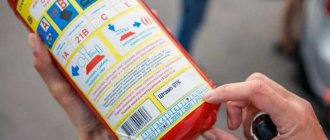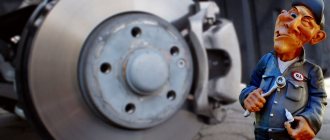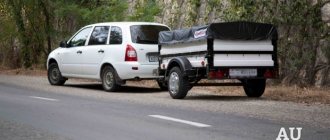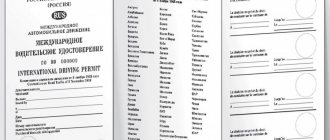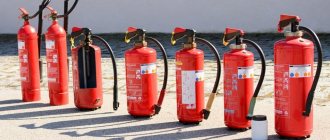Almost every family now has a car as a comfortable and convenient means of transportation. However, it is not as safe as we would like.
All types of vehicles are classified as vehicles with a high risk of fire hazard. A fire can occur during a collision during a traffic accident, and the cause of the fire can be a short circuit or breakdown in the fuel and/or electrical system.
In this regard, the presence of a special extinguishing agent in the car is mandatory. What type of fire extinguisher should be in a passenger car will be discussed in this article.
Is a fire extinguisher required in a car by law?
A fire extinguisher is required to undergo maintenance. Device parameters, types and characteristics are specified in GOST, NPB.
| What is provided | Regulatory acts |
| Fire extinguisher requirements |
|
| Duty to have |
|
What volume of fire extinguisher should be
Manual and automatic units of greater mass are allowed, but not below the prescribed parameters. The device must be intended by the manufacturer for motor vehicles (ATS).
| Cars | Volume not lower (l) | Charge mass (not cylinder) not less (kg) |
| Cars | 2 | 2 |
| Freight |
| |
How many fire extinguishers should there be?
The number of extinguishing devices for vehicle registration and maintenance is regulated by SP 9.13130.2009 (Appendix B, clauses B1 - B2) and the “Fire Safety Rules” (clause 212). The parameter depends on the weight, purpose, and capacity of the machine.
In a car
Passenger cars are equipped with at least 1 product with a charge weight of 2 kg and 2 liters. Required capabilities: extinguishes model fires from 0.7A and 21B.
In a truck
For cargo vehicles you will need:
- for vehicles up to 3.5 t - one (2 kg, 2 l, from 0.7A and 21V);
- trucks for transporting people or weighing from 3.5 to 7.5 tons, combines, tractors - two similar;
- Vehicles from 7.5 tons, transporting dangerous goods (trucks, fuel tankers, tank trucks) - two from 2A and 70B.
In the bus
For buses weighing from 3.5 - 7.5 tons, you will need 2 similar fire extinguishers with a charge weight of 2 kg, 2 liters.
Shelf life of a car fire extinguisher
All containers are subject to a mandatory full check with a change of charge every 5 years, even if all indicators are normal. The manufacturer may also provide for increased frequency of maintenance.
| View | Shelf life for technical inspection (years) | Charge life and recharging (at least) |
| Carbon dioxide | Up to 15 – 20 |
|
| Powder | To 10 |
Charge updates are carried out more frequently if specified by the manufacturer. For example, powder-type automobile fire extinguishers of some models are prescribed to be refilled once every 4 or 1.5 years, and carbon dioxide fire extinguishers - once every 2 years.
Passing the technical inspection includes inspecting the fire extinguishing device, filters, all components, and checking the mass of the charge by weighing.
A full recharge will be required after use or if the charge weight deviates from 5%. The container may be declared unusable ahead of schedule. They don’t restore it – they replace it with a new one.
The release date is indicated on the case by the manufacturer (a piece of paper is torn off opposite the number):
- Arabic numerals – year of manufacture;
- Roman - month.
Expiration and inspection dates are entered by the manufacturer and specialized organizations into technical documents and stickers on the case.
The cost of refilling an OP is almost equal to the price of a new product - as a rule, it is better to buy a new one if its service life has passed.
Fine for not having a fire extinguisher
The list of malfunctions and violations leading to a ban on the operation of a vehicle (clause 7.7 of Chapter 7 of the Traffic Regulations) includes the absence of a car fire extinguisher. If there are compelling reasons, the traffic police inspector inspects the car.
The fine for an expired fire extinguisher or its absence is provided for in Art. 12.5 Code of Administrative Offenses – 500 rubles. Fixed size. The inspector has the right to limit himself to a warning.
This is interesting: Portable powder fire extinguisher OPU-2: performance characteristics and description
Fire extinguisher expiration date
Automotive fire extinguishing agent has an expiration date. When a fire extinguisher expires, you can refill it or purchase a new one.
Experts advise purchasing a new product, since recharging is only slightly cheaper.
An expired device loses operating pressure due to shaking in the car, changes the properties of the powder (the shelf life of a powder fire extinguisher is 1.5 years, a carbon dioxide one is 5 years), due to which the quality of fire extinguishing suffers.
The expiration date expires earlier if traces of corrosion are noticed on the surface of the cylinder. It is dangerous to use a damaged device. With careful storage, the service life of a car fire extinguisher cylinder is limited to 10 years with the possibility of recharging during this time.
It is necessary to check the expiration date of a car fire extinguisher periodically, and not just during a technical inspection. The product is inspected once every three months for damage, and filters are checked annually.
Requirements for a fire extinguisher for a car
A list of requirements for fire extinguishers was developed by the Ministry of Emergency Situations and Rospozhnadzor in order to reduce the number of fires and prevent casualties. It has not changed this year either.
The criteria that a fire extinguisher in a car must meet are as follows:
Compliance with current GOSTs (R51057-2001 or NPB 155-2002).- Fire extinguisher volume : 2 liters - for cars, 5 liters - for fire extinguishers used in trucks.
- Weight of a refilled fire extinguisher: 2 kg for cars, 5 kg for trucks.
- Best before date. Over time, a refilled fire extinguisher loses pressure, and the beneficial properties of the extinguishing mixture are also lost. The expiration date and date of inspection, refueling or recharging are marked on the fire extinguisher itself.
- Marking. The fire extinguisher must be marked with everything from instructions for use to a description of the action of the extinguishing mixture.
- Type of extinguishing agent. In 2021, as before, 2 main types of fire extinguishers are used - powder and carbon dioxide.
The most important thing is that the fire extinguisher is in good working order and suitable for use. An annual inspection during a technical inspection involves a detailed inspection of this device, opening and checking the filters.
Everything is checked:
condition of the protective coating;- flexible hose;
- spray;
- seal on the safety device;
- serviceability of the pressure gauge and pressure indicator;
- presence of a mark;
- pressure inside the cylinder;
- The weight of the equipment is measured.
At the end of the procedure, marks are placed in the fire extinguisher passport, and the device itself is entered into the accounting log. If a fire extinguisher is found to be inoperative, it must be disposed of or recharged.
Video: Car fire extinguisher
Types of automobile fire extinguishers
A car enthusiast should not doubt whether a fire extinguisher is needed in his car - he definitely does. There are several types of these devices.
Water or combined water-air products cannot be used to extinguish a car, as water causes an electrical short circuit. But even if this does not happen, water is not enough to extinguish a fire in a car; it will only damage the equipment and upholstery.
For the same reason, foam fire extinguishers are not suitable for use in a car, since the extinguishing composition is water-based.
Dry chemical devices are filled with powder or foam. The substance is pushed out under the influence of nitrogen, which is pumped into an additional cylinder. They can be used to extinguish car fires.
ABC is a fire extinguisher filled with yellow powder – ammophos. A fairly universal product, but the powder can damage electrical devices and leaves sticky residue.
The most preferred are automobile fire extinguishers, the types and characteristics of which are determined by the Ministry of Emergency Situations and Rospozhnadzor. They recommend purchasing powder or carbon dioxide devices. Each option has both pros and cons.
Powder fire extinguisher
This type of product is marked with the letters “OP”, which stands for powder fire extinguisher. The composition is a solution of sodium bicarbonate or potassium bicarbonate. Upon contact with combustion products, it is converted into dense foam, which evenly covers the surface, preventing the access of oxygen.
Additional markings
- "G". The design includes a gas-generating cartridge, thanks to which increased pressure is created inside due to a chemical reaction.
- "Z". Inflated cylinder. The extinguishing agent is pumped inside under pressure and the container is sealed. This device is easy to use.
- "B". A compressed air cylinder is placed inside the main cylinder. When you press the lever, it depressurizes, and a stream of gas ensures the ejection of the extinguishing agent.
When choosing a powder fire extinguishing agent, take into account that the contents of cylinders with a gas-generating cartridge and a built-in cylinder begin to spray approximately 5 seconds after activation, since it takes time for the chemical reaction to occur and the creation of the necessary pressure inside the cylinder.
Powder fire extinguisher
Advantages of powder fire extinguishers:
- after treating the area, a secondary fire is excluded;
- capable of extinguishing fires from class A to E;
- operating ambient temperature from -60 to +50°C;
- lightweight, compact and inexpensive.
Flaws:
- no cooling effect;
- It is difficult to remove the composition from the surface after extinguishing a fire, but it is necessary as soon as possible. The remaining residue causes damage to moving parts and electrical equipment.
Carbon dioxide fire extinguisher
Marked with the letters "OU". It contains carbon dioxide CO2 in a compressed state. When the device is activated, carbon dioxide is released from the cylinder under pressure. The jet of the composition knocks down the open fire.
Advantages of carbon dioxide fire extinguishing agent:
- effectiveness in extinguishing fires in hard-to-reach places;
- lack of hard-to-rinse foam - it leaves absolutely no traces;
- gas has dielectric properties.
Flaws:
- powerful recoil;
- the surface of the cylinder accumulates a static charge;
- high concentration of dioxide in the immediate vicinity of use, which causes poisoning and suffocation. The carbon dioxide device must absolutely not be used in a closed cabin with people present;
- the likelihood of cold burns if used incorrectly;
- not suitable for extinguishing class A fires, i.e. when burning solid substances such as plastics or textiles;
- leaks due to vibration (leakage per year ranges from 20 to 50 g);
- greater weight and cost.
Carbon dioxide fire extinguisher
Powder and carbon dioxide fire extinguishers: which is better?
There are several types of fire extinguishers, but in 2021 it is recommended to use only 2 of them for cars - powder and carbon dioxide. Let's take a closer look at the advantages and disadvantages of each of them.
Powder
This type of fire extinguishing device contains a special fire extinguishing powder that forms a dense foam composition that blocks the access of oxygen.
As a result, the fire is extinguished and the fire is eliminated. The marking of these devices is OP, that is, a powder fire extinguisher.
In addition, the device may have additional symbols, for example:
- “G” – equipped with a gas-generating cartridge;
- “Z” – download;
- “B” is a gas cylinder under pressure.
This marking indicates the method of creating pressure. It should be noted that the last 2 types of fire extinguishers fire with a delay of about 5 seconds.
Powder fire extinguishers have a number of advantages:
- extinguish fires of any complexity (classes A-E);
- prevent secondary fire;
- they are lighter and cheaper than other types of devices.
It is also necessary to identify the disadvantages of the OP:
- very pollute the surface;
- Adhered powder is difficult to wash off.
Carbon dioxide (CO)
The active substance here is carbon dioxide (CO2). When filled, carbon dioxide is compressed to the limit, eliminating the need for additional pressure build-up.
The fire is eliminated with the help of a powerful jet of carbon dioxide, which lowers the temperature in the fireplace and knocks out the fire. These fire extinguishers are especially effective when it is necessary to extinguish a fire in places of difficult access.
In addition, after using the op-amp, there is no need to wash the car from foam.
However, there are certain risks when using carbon dioxide fire extinguishers, such as:
- Dioxide poisoning.
- Causing burns from rastrud.
- The recoil resulting from the strong flow of gas can tear the fire extinguisher out of your hands.
Although carbon dioxide fire extinguishers have slightly better characteristics, they are heavier than powder ones and 2-3 times more expensive. The optimal solution for a passenger car is a powder fire extinguisher.
The fire extinguisher must be refilled. Powder devices are refilled every 1.5 years, and carbon dioxide devices – once every 5 years.
What kind of fire extinguisher should be in a car?
Every passenger car must be equipped with a carbon dioxide or powder fire extinguisher with a volume of at least 2 liters. But as practice shows, the extinguishing ability of a 2-kilogram device is small. Therefore, if you are planning to acquire new fire-fighting equipment, pay attention to the OP-4 model.
This type of fire extinguisher has a powder mixture and a volume of 4 liters. This will allow you to significantly influence the source of ignition in an emergency situation. Indeed, in fact, 2-liter equipment produces two powerful sprays lasting just over 1.5 seconds. The first click in most cases is a test press. In short, a minimum volume fire suppression device is unlikely to be effective.
It is worth noting that the fire extinguisher must be located in the passenger compartment, directly within the driver’s reach. Otherwise, it may not be of any use.
Useful tips for drivers
The best place to store the cylinder is the car door. The fire extinguisher is secured using a bracket with a lock. It is acceptable to keep the cylinder in the trunk or under the passenger seat. This option is much better than no fire protection at all.
If the fire extinguisher has a plastic body, it is worth replacing it with a metal cylinder. Plastic is highly flammable.
It is not recommended to purchase fire extinguishers that are not provided for by regulatory documents. For example, water-foam cylinders are practically not used for cars.
If the cylinder has expired, it is replaced with a new one. This fire extinguisher is handed over to a recycling or scrap metal collection point.
What is the fine if there is no fire extinguisher?
Not having a fire extinguisher is considered an offense, which is provided for in Part 1 of Article 12.5 of the Code of Administrative Offenses of the Russian Federation.
The fine in this case is 500 rubles. The same amount is paid if the fire extinguisher has expired. The fine must be paid within 60 days from the date of issuance of the resolution on its appointment (Part 1 of Article 32.2 of the Code of Administrative Offenses of the Russian Federation). And despite the fact that if you do not have a fire extinguisher, you should not use the vehicle, traffic police officers are prohibited from:
- Disqualify you from driving a car.
- Detain the car and send it to the impound lot, since this violation is not on the list of grounds for detention (Article 27.13 of the Code of Administrative Offenses of the Russian Federation).
The best carbon dioxide fire extinguishers
Models of this group are widely used to eliminate fires of flammable liquid and gaseous substances, components and devices under voltage. When used, traces of extinguishing remove themselves, which eliminates the need for chemical cleaning of the car. These products have found their place in cars and everyday life.
The disadvantage of such devices is its harmful effect on the human body, as well as its high level compared to other fire extinguishers.
Yarpozhinvestf OU-3
This model from the Yaroslavl company is ideal for extinguishing class B and C fires (liquid and gaseous flammable substances), as well as electrical wiring under voltage up to 1000V. Carbon dioxide is released at a pressure of 5.88 MPa and blocks the access of oxygen to the site of flame formation.
Pros of a fire extinguisher:
- Long service life - 10 years.
- Use at temperatures from -40 to +50°C.
- Large mass of fire extinguishing agent 3.0 kg.
- Bright, easy to read instructions with pictures.
Disadvantages of a fire extinguisher:
- Increased weight: 10.5 kg.
- There is a possibility of skin frostbite if the substance comes into contact with it.
Pozhzakhist OU-5 (VVK-3.5)
This is a pump-type carbon dioxide fire extinguisher from a company from Mariupol. It copes well with class B, C, E fires. A jet of snow-like substance (temperature -78°C) released under a pressure of 58 atmospheres can quickly extinguish a fire over an area of up to 2 m2. When extinguishing solid objects: wood, cardboard, paper, smoldering coals may remain.
Pros of a fire extinguisher:
- Large fire extinguishing agent: 3.5 kg.
- Long jet length: from 3 m.
- Supply time sufficient to extinguish fire: 8 seconds.
- Operates over a wide temperature range: -20 – +50°C.
- Rechargeable.
Disadvantages of a fire extinguisher:
- Not detected.
Manufacturers guarantee proper operation of the fire extinguisher for 10 years.
This is interesting: Powder fire extinguishing installations (systems): types, installation, requirements
Checking fire extinguishers
The inspection takes place every quarter at a convenient inspection point. During such checks, the presence of a fire extinguisher and its location are confirmed. And the annual inspection already includes a full examination of the device, during which the traffic police officer checks:
- hose flexibility;
- pressure gauge and pressure indicator;
- protective covering;
- filling;
- presence of a mark;
- spray;
- intraballoon pressure;
- weight is measured.
The last step during verification is a special mark in the device’s passport, after which it is entered into the accounting journal. A device that fails the test is either disposed of or recharged.
If you are stopped by a traffic police inspector, then according to paragraph 2.1.1 of the traffic rules, all that he will ask you to show is a car registration certificate, a driver’s license, etc. - there is no fire extinguisher on this list.
The driver should remember that this paragraph relates to checking the technical condition of the car, which requires special justification (clause 110 of the Administrative Regulations of the State Traffic Safety Inspectorate, approved by Order of the Ministry of Internal Affairs dated August 23, 2017 No. 664).
Do not forget that a fire extinguisher is necessary not only to successfully pass the test, but to be able to get by with only minor losses in the event of a possible fire, not to mention saving lives. Therefore, it is necessary to take full responsibility when choosing a fire extinguisher for your vehicle.
Current requirements in JSC
A fire extinguisher is not a device whose development does not require compliance with various standards and requirements. Since we are talking about fire safety, there is nothing strange in the fact that structures such as the Ministry of Emergency Situations and Rospozharnadzor are developing these requirements. This year, all relevant documentation has remained unchanged. We list the basic requirements for automobile fire extinguishers:
- compliance with GOST R510572001 and NBP 1552002. OT must be certified in accordance with the requirements of GOSTR, which must be recorded in the SSPB register;
- volume requirements: for passenger cars no more than 2 liters, for trucks – 5 or more liters;
- The weight of a car fire extinguisher in working (fully charged) condition should be 2 kg. for a passenger car and 5 for a truck;
- The shelf life requirements are also quite stringent, since over time the pressure in the OT chamber gradually drops, which also leads to a deterioration in the fire-fighting properties of the working mixture. The expiration date of the fire extinguisher is applied directly to the container by the manufacturer, and information about refills is applied by the organization that carried out this procedure. It is important not to let the device expire;
- A car fire extinguisher must be labeled indicating the working mixture used and instructions describing how to use the device.
Checking the vehicle's compliance with expiration dates falls on the shoulders of the car owner, but for safety reasons, as part of annual maintenance, service center specialists must carry out this procedure, which includes the following measures:
- the presence of a protective coating on the device and its integrity;
- the tightness of the hose and/or pipes, the absence of cracks and other defects;
- sprayer performance;
- the presence of an intact filling;
- technical condition of the pressure gauge and its readings;
- pressure level in the container, weight of the fire extinguisher.
If any of the described malfunctions are present, measures will be taken to eliminate them, and if this is not possible, the device must be disposed of. If everything is normal, a corresponding entry is made in the OT passport.
Fire extinguishers for vehicles - what are they?
The devices we are interested in, designed to extinguish a fire in a car, can be filled with different substances. According to this indicator they are divided into:
- aerosol;
- carbon dioxide;
- powder
Devices for extinguishing fire in a car
Aerosol fire extinguishers (they are also called air-foam) are characterized by their small size, which is very popular with car owners. Due to their compact parameters, mounting them inside the car on a special holder does not cause any difficulties, and they do not take up much space. This is where, in principle, all the advantages of aerosol “fire extinguishers” end. In the event of a real fire, such devices filled with foam will not help you in any way due to their low efficiency. In addition, their refueling and refueling is a rather complex process.
Carbon dioxide devices filled with carbon dioxide can be more beneficial. It is in a compressed form in the device, which makes it possible to use it instantly - there are no delays associated with the need to create pressure in the fire extinguisher. The fire in this case is extinguished due to the fact that the device emits a high-power flow of extinguishing agent, which, firstly, knocks down the fire, and secondly, cools the burning surface. Refilling carbon dioxide fire extinguishers also poses problems due to the toxicity of the dioxide.
Carbon dioxide fire extinguishing device
The most popular among domestic drivers are powder automobile fire extinguishers, in which a special mixture is stored in the form of fine powder.
This composition is sprayed onto the source of fire, and its chemical reaction with the burning products begins. The result of the process is the formation of a dense layer on the latter, which counteracts the spread of fire, blocking the supply of oxygen.
Rating TOP 10 best fire extinguishers for cars
The rating of the best fire extinguishers includes the following models:
- Melanti OP-2.
- MIG OP-2.
- Yarpozhinvest OP-2.
- RIF OU-2.
- Yarpozhinvest OU-2.
- Frost OU-2.
- OP-4(Z)-ABCE MIG.
- OP (plastic).
- TD Rusintek OVE-5.
- NPO Advanced Technologies OVE-2.
Let's take a closer look at the range presented above.
Melanti OP-2
An inexpensive domestic fire extinguisher, which at one time became the winner of the “Zarulevsky” test, which is now proudly announced by a separate sticker on the body, is a classic “car” version. The fire extinguisher is filled with Volgalit-AVSE powder produced by Nizhny Novgorod JSC V.V.P., which is considered one of the best among domestic ones in terms of efficiency. The fire extinguisher releases powder quickly and powerfully, and if you weigh it before and after use, the stated two kilograms of refill are confirmed with good accuracy.
| Jet length | 2 m |
| Charge mass | 2 kg |
| Manufacturer country | Russia |
Price category: from 550 to 680 rubles.
- jet 2 m long;
- charge - 2 kg;
- extinguishing class A, B, C, E fires;
- full charge generation.
- not found.
I tried to shoot the fire extinguisher after the expiration date expired - it works as expected, so I’m confident in it, I’m taking this particular model as a replacement. In Russia, this unit is quite popular, and it doesn’t break the bank’s budget; it copes with its functions perfectly. Thanks recommend.
fire extinguisher for cars Melanti OP-2
MIG OP-2
This 2.5 liter automotive powder fire extinguisher has increased fire extinguishing ability with a charge of 2 kg. Designed for use on vehicles of categories M1, M2, M3, N (EAEU TR 018/2011) - passenger cars, buses, trucks. The fire extinguisher is completely emptied in approximately 6 seconds - this factor allows time to cover a large area when extinguishing. Vexon ABC 25 powder was used for filling.
| Charge mass | 2 kg |
| Manufacturer country | Belarus |
| Jet length | 2 m |
Price tag: from 700 to 900 rubles.
- duration of supply of the substance is from 6 seconds;
- high-quality powder (Vekson ABC 25);
- charge - 2 kg.
- not found.
Perfect for drivers of passenger cars due to its optimal charge and volume of 2.5 liters. The high-quality powder is charged inside, and the model itself is reasonably priced. There was already a case when it was urgently necessary to extinguish a seat in a car, thank God there was a fire extinguisher at hand, the skin burned in a second, so Mig really saved both me and the car. Thank you.
fire extinguisher for cars MIG OP-2
Yarpozhinvest OP-2
The device in question is intended for the purpose of primary extinguishing fires and fires of class A, B, C, E (flammable and flammable liquids, solid flammable substances and gases, electrical installations not exceeding a voltage of 1000 Volts). Supplied with a sprayer on the ZPU. The manufacturer's warranty is given for only one year from the date of sale, and then only on the condition that no more than one and a half years have passed since the date of release.
| Manufacturer country | Russia |
| Jet length | 4 m |
| Charge mass | 2 kg |
Cost: from 400 to 560 rubles.
- long jet (4 m);
- charge - 2 kg;
- extinguishing class A, B, C, E fires.
- low shelf life (from technical inspection to technical inspection).
The small price tag attracts first of all, and then the characteristics and other data. But if you compare it with other models, you can, of course, find better ones. The shelf life is incredibly short, this factor is the main disadvantage of the unit, but it extends the jet distance to 4 meters. The disadvantages are outweighed by the advantages, so I am neutral about this fire extinguisher. I won’t recommend it, see for yourself.
fire extinguisher for cars Yarpozhinvest OP-2
RIF OU-2
The presented carbon dioxide apparatus is designed for rapid cooling of the surface and dispersion of gas. Thanks to the action of carbon dioxide, material values are practically not destroyed, and there are no streaks or stains left on them. The fire stops due to cooling of the combustion area. The fire extinguisher is especially effective for localizing fires at the initial stage and those types of fires where the use of water is prohibited.


